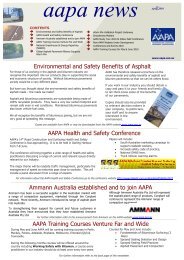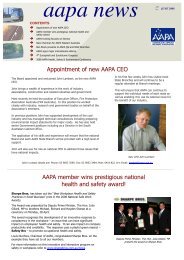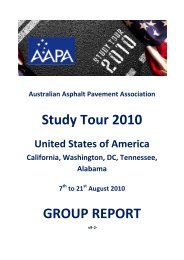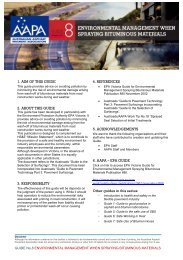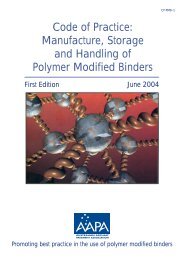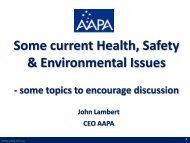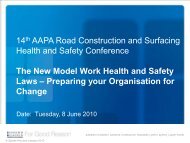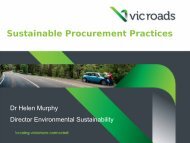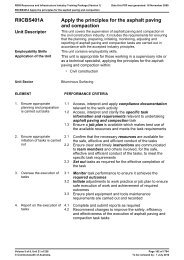Asphalt Review - Volume 29 Number 2 (June / July 2010)
Asphalt Review - Volume 29 Number 2 (June / July 2010)
Asphalt Review - Volume 29 Number 2 (June / July 2010)
You also want an ePaper? Increase the reach of your titles
YUMPU automatically turns print PDFs into web optimized ePapers that Google loves.
ASPHALT REVIEW<br />
a range of different WMA materials.<br />
The asphalt companies also agreed to<br />
fund the initial and ongoing extensive<br />
asphalt testing that was required under<br />
the Evaluation Protocol. The testing will<br />
be monitored by state road authority and<br />
ARRB personnel.<br />
To ensure consistency in placement<br />
reduce costs and enhance practicality,<br />
one company undertook all the<br />
placement. This highlighted the high<br />
level of cooperation between all the<br />
parties involved in this major project. It<br />
also ensured consistency in the laying of<br />
the samples and meant that all sections<br />
could be laid over three nights, reducing<br />
disruption to traffic.<br />
The Project required placing 21<br />
different WMA and hot mix wearing<br />
course sections of asphalt in a grid<br />
pattern on the section of the roadway<br />
and this was undertaken in April <strong>2010</strong>.<br />
Two foamed WMA processes and two<br />
additive WMA processes were used to<br />
produce the WMA materials. Some WMA<br />
materials were made with new aggregates<br />
and others with differing proportions of<br />
reclaimed asphalt pavement (RAP), from<br />
10% up to 50% RAP.<br />
Testing of the asphalt materials used<br />
could not be completed by a single<br />
laboratory given the large number of<br />
samples.<br />
As a result, each participating asphalt<br />
company prepared the specimens and<br />
completed testing for their own mixes.<br />
Representatives from Queensland<br />
Transport and Main Roads, NSW Roads<br />
and Traffic Authority, South Australian<br />
Department of Transport Energy and<br />
Infrastructure, VicRoads and ARRB<br />
were present during the preparation<br />
of samples and during the asphalt<br />
placement.<br />
The asphalt specimens are currently<br />
being tested by the asphalt companies<br />
with state road authority and ARRB<br />
observers monitoring that testing. The<br />
observers will continue to monitor<br />
all testing undertaken throughout<br />
this project to ensure accuracy and<br />
consistency.<br />
As outlined in the Validation Project<br />
Protocol, this project will continue<br />
for a period of at least two summers.<br />
During that time, industry, ARRB and<br />
state road authority members will<br />
continue to monitor the performance<br />
of the pavements. This will provide<br />
a clear understanding of the relative<br />
performance of WMA to hot mix.<br />
It is expected the outcomes of the<br />
validation project will confirm that<br />
WMA, with or without RAP, is as reliable<br />
as hot mix. But whatever the outcome,<br />
this project will enable both government<br />
and industry to better understand<br />
the opportunities to use WMA across<br />
Australia. It will also help to achieve<br />
greater consistency in specifications<br />
across Australia and will support the early<br />
use of WMA with all its environmental,<br />
economic and safety benefits.<br />
The project highlights the benefits<br />
of industry and Austroads/state road<br />
authorities working together through<br />
AAPA to achieve outcomes that benefit<br />
all parties. It not only reduces the costs<br />
to any single organisation, it significantly<br />
reduces the need for duplication.<br />
Importantly, the project also highlights<br />
how government and industry can work<br />
effectively together through AAPA.<br />
This is highlighted in a letter from<br />
Andrew Milazzo, Executive Director of<br />
the SA Department for Transport, Energy<br />
and Infrastructure, sent to the AAPA<br />
CEO, John Lambert, about the project:<br />
“The Department is delighted to be<br />
involved in a project such as this which<br />
encompasses the State Government’s<br />
strategic goals of attaining sustainability<br />
through greenhouse gas emissions<br />
reduction and improving wellbeing<br />
through greater safety at work.<br />
I appreciate the co-operative approach<br />
you have taken with the free flow<br />
of information, showing a genuine<br />
commitment from industry.” Further<br />
information on this project will be<br />
made available on the AAPA website<br />
and in future editions of <strong>Asphalt</strong> <strong>Review</strong>.<br />
Information can also be obtained from<br />
the joint project managers, Cassandra<br />
Simpson (AAPA) and Kieran Sharp<br />
(ARRB).<br />
20 ROADS JUNE <strong>2010</strong>/JULY <strong>2010</strong>



